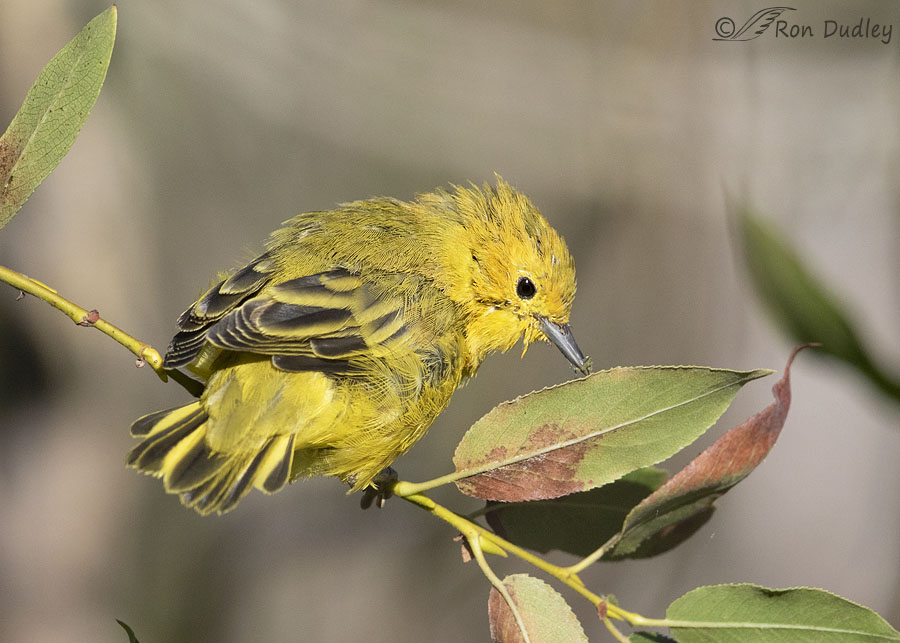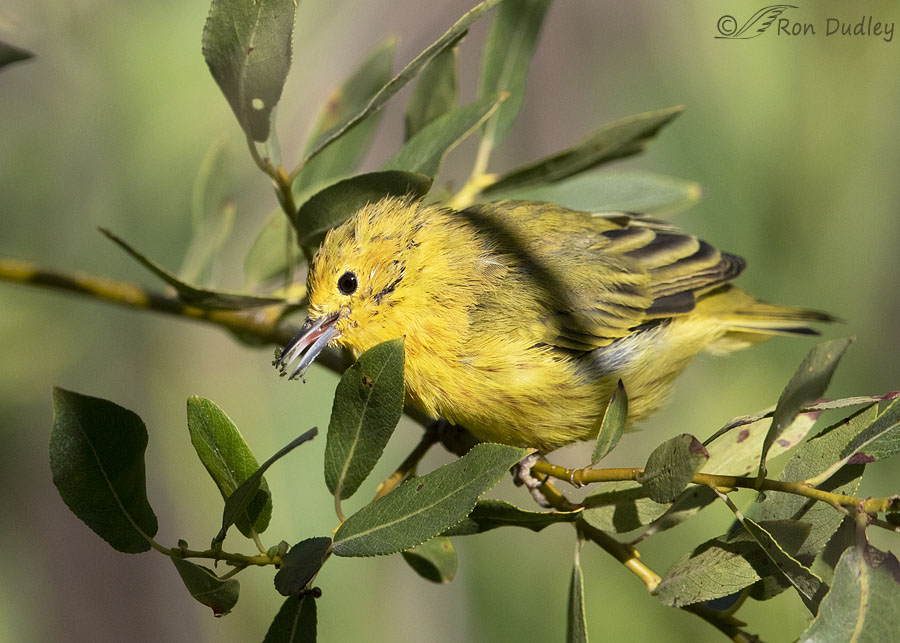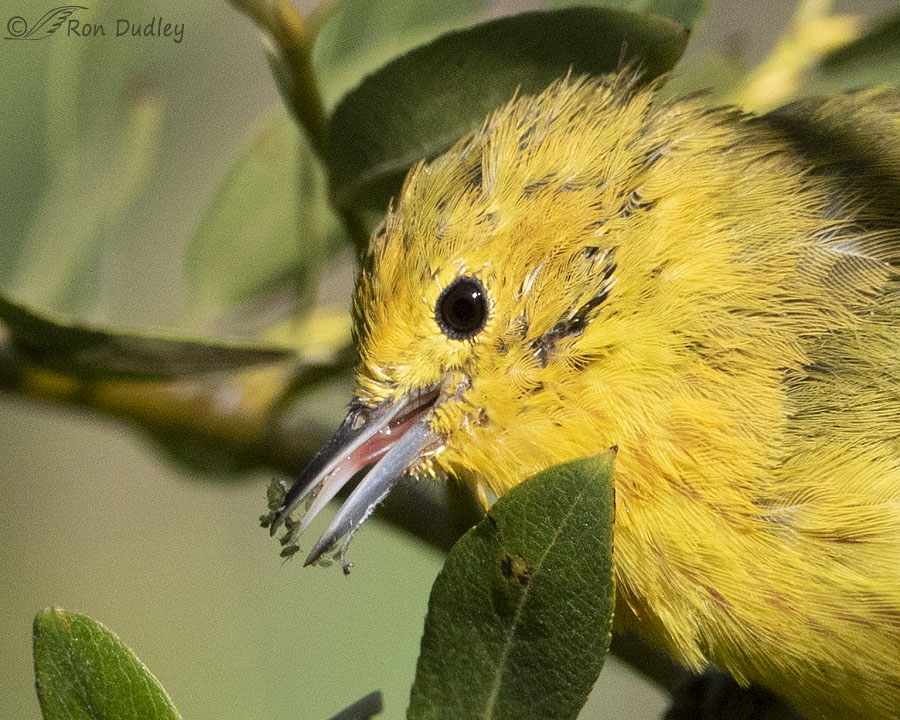It’s only a working theory but I believe it’s based on fairly strong circumstantial evidence.

1/5000, f/6.3, ISO 800, Canon 7D Mark II, Canon EF 500mm f/4L IS II USM + EF 1.4 III Extender, not baited, set up or called in
Yesterday morning in the mountains I spent considerable time trying to follow this extremely uncooperative Yellow Warbler with my lens as it foraged in the willows. Warblers are known to skulk in the bushes and rarely come out fully into the open but this one took that tendency to extremes. It was reasonably close for a very long time but only came out into the open sporadically and when it did it was nearly always for only an instant so my frustration level was high.
In this view we see that “his” tail is growing out most likely after molting and that there are aphids all over the tip of his bill. I never see them capturing the aphids off the leaves because aphid colonies are nearly always on the undersides of the leaves where I can’t see them. The warblers reach beneath the leaves to get at them. I’ve always assumed that they typically grasp individual aphids, or small groups of aphids, between their mandibles as a method of capture just like many other insectivorous birds.
But based on these and other photos I’ve taken this summer I’ve become more skeptical of that assumption.

1/5000, f/6.3, ISO 800, Canon 7D Mark II, Canon EF 500mm f/4L IS II USM + EF 1.4 III Extender, not baited, set up or called in
Aphids are notoriously sticky. As they feed they secrete large amounts of a sticky substance known as honeydew. That’s what attracts some ant species to aphids so they can “milk” the honeydew in their well-known aphid farming operation. Here there are aphids stuck all over the tips of both mandibles.

In a huge crop of the previous image we see the bird using his tongue to pull the aphids into his mouth.
When I’m photographing Yellow Warbler adults and juveniles foraging on aphids they often, even usually, have large numbers of aphids stuck to the outside of their bills. That makes me wonder if their feeding strategy isn’t to sweep the tips of their bills through the aphid colonies so they’ll stick to their bills and then they can lick them off once they’ve been captured that way. If so that may be why I see so many aphids stuck to their bills and it’s different from any other feeding strategy I’ve observed.
Speculation to some degree to be sure but based on what I’ve seen and photographed it makes sense to me.
Much ado about nothing? Not to me it isn’t.
Ron
Notes:
- Perhaps they use both strategies – grasping aphids in their bills and sweeping their bills through the colony to take advantage of their stickiness.
- More speculation. I often see a few aphids on the midline of the upper mandible and the bird seems to make no attempt to get at them for quite a while. Aphids even seem to build up on the midline. That makes me wonder if their tongue can’t reach the midline for some reason.
- I’m slightly baffled by the material running lengthwise on the midline of the ventral surface of the lower mandible in the last photo. Perhaps it’s only debris but it’s the same color as the bill which makes me wonder if it isn’t integral to the bill. I’ve seen some birds, kestrels in particular, with keratin peeling off their bills but this looks quite different. Any thoughts?


I wonder if when they gather a bunch of aphids like this they then scrape them offonto a branch and ,from there, gobble them down…(RON, please send all your extra Yellow Warblers to Ellie Baby…she needs some…Thanks)
If I had any extra I would, Patty…
I WANT a flock of yellow warblers. And yet again am grateful to start my day with beauty, with learning, with a theory to ponder from you and your knowledgeable commentators.
Many thanks.
Ha, I want one too, EC. I’ve never once seen one in my neighborhood.
Next time we have an adult in rehab I will look at the bill.
Sounds like a plan!
Cute bird and good photos Ron. I need that guy in my garden to remove aphids I’m not sure if I have ever seen a Yellow Warbler. Will have to check.
Thanks, Everett. They’re common around here in summer.
Wonderful series. I think you may be on to something. Have you ever seen this from any other birds, especially warblers? I see several possibilities. It could be an accident, but I tend to agree with you that it seems like a deliberate action. If that is the case, is this something one bird learned by accident, a species behavior, or a behavior in other warblers? It’s not something all aphid-eating birds do. I have watched a Black-capped Chickadee and a Swainson’s Thrush each carefully pick off aphids with the tip of the beak. In the case of the chickadee, when an aphid did get stuck to the beak, it immediately scraped it off on a branch then went back to plucking off individual aphids. This is a great behavior to document and I hope you can find more evidence in other individuals or other species.
It’s hard to tell for sure about what is happening with the beak. All birds have a thin keratin sheath over the beak called the rhamphotheca. It continuously grows and can sometimes be damaged and tear loose or peel. Nutritional problems can also cause it partially peel. In most birds this is very thin but in alcids, especially puffins, it becomes quite enlarged and is a breeding ornament that is shed after the breeding season. In warblers and other songbirds, it is quite thin, but still subject to occasional damage.
Thanks very much, Dan. I anxiously awaited your potential comment this morning because of your extensive knowledge of birds and because I trust your judgment.
As usual I wasn’t disappointed.
No, I’ve never seen the behavior in other warblers but that doesn’t mean much. Most, as in nearly all, of the warblers I photograph are Yellow Warblers and I’ve never specifically noticed another species feeding on aphids that I was aware of.
BTW, I was delighted to read Barbara’s positive report on your medical situation this morning.
The first shot is great — got quite the chuckle as that stubby tail adds to his overall disheveled appearance. Looks like he’s getting his meal and then saving a snack for later, although I wonder how he’s going to get at the aphids beyond his tongue’s reach. I’m thinking maybe he’ll wipe them on a branch and nibble from there. I’d sure be happy to have a couple of Yellow Warblers hanging out in my garden — for obvious reasons and to get the aphids off my roses. 😃
Marty, that’s something I’ll have to watch for. They often wipe their bills on a branch to clean them off so I’ll watch for them eating aphids that have been removed.
Delightful closeups! So interesting. Thanks for the interesting way to start the day – to quote Kathy.
Thanks, Joanne.
Hmmmm Aphids are sticky for sure – are juveniles just sloppy eaters or is it a strategy??? Looks like debris to me since there seems to be definite end to it closer to the mouth…… Puzzles for me for sure! They are cute birds and frustrating to “try” to photograph! 🙂
Thanks, Judy. Warblers are usually frustrating to try to photograph but this one took it a few steps further than that.
As to what is peeling off, I think it is detritus from the way it is peeling. 🙂
Maybe…
Another interesting start to the day! It’s rather a smart way to gather your food…faster for sure and probably more efficient. I remember my mother’s parakeet’s beaks peeling way back when…a normal process I think. After all, our nails do the same thing so why not their beaks. You do like to start our days with puzzles to wake us up. 🙂 By the way your first photo was an eye catcher with that very short tail! Cute!
Thanks, Kathy. There have been a lot of birds around here lately with short or nonexistent tails. It’s that time of year…